American Cakes: Red Velvet Cake – A traditional recipe and history for Red Velvet Cake with Cream Cheese or Whipped Roux Frosting from food historian Gil Marks.
Red velvet cake — also known as “red Waldorf cake,” “Waldorf red cake,” “Waldorf Astoria red cake,” “red carpet cake,” “red mystery cake,” “flame cake,” and “$300 cake” (or a range of other dollar amounts) — is a layer cake with a subtle chocolate flavor and a distinctive bright red hue produced by a considerable amount of red food coloring. It is most typically dramatically contrasted with a rich, soft, and fluffy white frosting that provides much of the cake’s flavor punch and color contrast. The first verifiable record of this artificially-colored cake was in 1959 and of the term “red velvet cake” in the following year.
On the other hand, “velvet cake” — without the adjective red and not connoting our subject — dates back to the post-Civil War period, referring to a tender, moist, and smooth texture. In this vein, the “Velvet Cake” in the August 1871 issue of The New Dominion Monthly (Montreal) and identical recipe in the November 1871 issue of Ballou’s Monthly Magazine (Boston) was a lemon extract-flavored butter cake loaf. A “Brown Velvet Chocolate Cake” –- without a drop of food coloring — was popularized in the 1940s.
The unrelated addition of “red” to a chocolate cake’s name initially arose due to the chemical reaction of acid in unsweetened bar chocolate and natural (non-alkalized) cocoa powder in conjunction with an acidic liquid (generally buttermilk or sour milk) with an alkali (baking soda), which reveals the red anthocyanin, a water-soluble vacuolar pigment. (In contrast, chocolate cakes made with baking powder and a non-acidic liquid turn out blackish in color.) Near the beginning of the 20th century, these chocolate cakes became known as “red cake,” “red regal cake,” “red feather [as in light-as-a-feather] cake,” “feather devil’s food cake,” and “red devil’s food cake.” However, their slightly reddish-dark brown hue was quite different from and much duller than food coloring-enhanced red velvet.
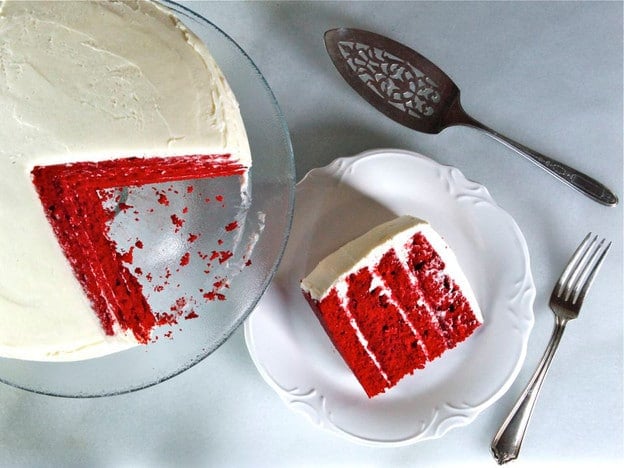
The idea of artificially tinting a cake red (or more commonly pinkish) — without chocolate –- already appeared in American sources in the 1870s, such as a “Watermelon Cake” in Buckeye Cookery by Estelle Woods Wilcox (Minneapolis, 1877) consisting of two batters baked together in a tube pan. Near the beginning of the 1870s, Price Baking Powder Company of Chicago introduced Dr. Price’s Fruit Coloring — liquid commercial food colorings in small bottles for home use. Tinting foods became easier and eventually more commonplace. Unlike red velvet cakes, early 20th century cake recipes only called for a few drops to a teaspoonful to produce a pink color and it was not commonly used in red chocolate cakes.
The earliest cake incorporating a large amount of red food coloring was “Waldorf red cake” or “red Waldorf cake”, initially appearing in 1959. At that time, the Waldorf-Astoria Hotel had never served red velvet cake (or Waldorf red cake) or anything remotely like it. What first induced someone to dump an entire bottle or two of red food coloring into a cake batter? Some sources attribute the original “Red Velvet” to the Adams Extract & Spice Company of Gonzales, Texas attempting to increase sales in the 1940s –- this seems logical, as American corporations have long created dishes incorporating their products. However, the earliest verifiable record of the company’s association with the cake was circa 1962. Perhaps a 1950s housewife, dissatisfied with the brownish hue of her chocolate cakes, mixed in a lot of food coloring. Or maybe someone was careless in measuring. Or possibly a baker wanted a red cake for Valentine’s Day or another fitting occasion. Accidental or intended, the result is a flaming red cake — color playing an integral role in the way people perceive and enjoy food.
Waldorf red cake is not the same as the preexisting intensely chocolate, black-colored “Waldorf cake” and “Waldorf Astoria cake.” The chocolate Waldorf Astoria cake/Waldorf cake was the object of an urban legend. Just as folktales arose throughout history and were assumed by many to be true, the 20th century abounded with numerous urban legends, such as the woman who tried to dry her rain-drenched poodle in a microwave or giant alligators inhabiting the New York City sewer system. Like earlier tales, urban legends reflect a community’s anxieties and insecurities. Waldorf Astoria cake bears the distinction of being one of the earliest American foods to develop a widespread and enduring urban legend. A story circulated that a guest at the upscale Waldorf-Astoria Hotel on Park Avenue in New York City, dining at the hotel’s eminent restaurant, ordered a slice of fudge cake for dessert. The woman enjoyed it so much that she asked the waiter for the recipe, with which he complied. Upon receiving her hotel bill in the mail, however, there was a hefty charge for the recipe. To obtain revenge, she began to widely distribute the specifications for making the cake. This legend was later confused with red Waldorf cake/red velvet cake.
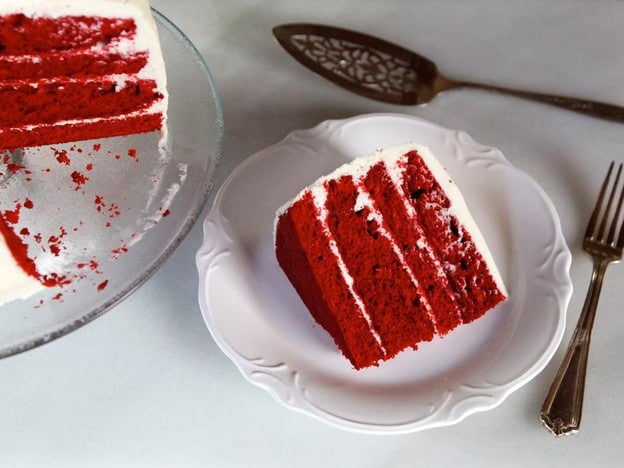
The epicenter of early Waldorf red cake mania was Ohio. The Friday May 22, 1959 issue of the Hillsboro Press-Gazette (Hillsboro, Ohio) noted about a hotel in a different city, Chicago, but with the name Waldorf: “This is a $300.00 recipe!” The paper’s recipe contained the archetypical batter but no frosting. Three days later, the Monday May 25, 1959 issue of the News-Journal (Mansfield, OH) published a recipe for “Waldorf (Red) Cake” including the standard white whipped roux frosting.
The first record in print of the modern name was in 1960. In that year, Foodland supermarkets in Seattle WA advertized “Waldorf Red Velvet Cake” in store bakeries. “Red Velvet Cake” appeared in the Thursday June 16, 1960 issue of the Denton Record-Chronicle (TX) as “Recipe of the Week.”
First prize at the 1960 Maryland State Fair was awarded to William Baker’s “Red Velvet Cake.” Eaton’s department stores in Canada, identified with this cake before going out of business in 1989, first mentioned it in a June 21, 1961 newspaper ad announcing: “Eaton’s new Red Velvet Cake.” “Red Velvet Cake” was included in the 1972 edition of Friedland Cook Book: Past and Present compiled by Woman’s Auxiliary, Friedland Moravian Church (Winston-Salem, NC), although it was not found in the original 1951 edition. The South became the hub of red velvet cake’s popularity.
Then in 1976, after several years of increasing controversy, the FDA de-listed Red Dye No. 2, the most widely used type, in the face of mounting public pressure (mostly based on suspect research and a belief by some that all coal-tar dyes should be banned). Many housewives stopped making red-dyed foods in general and the red velvet cake waned.
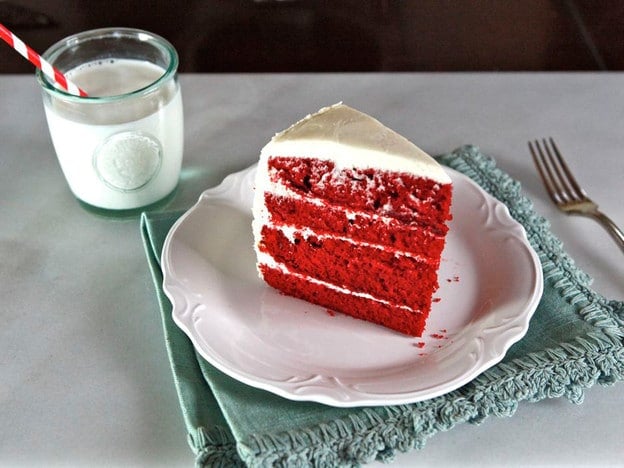
Subsequently, after a red velvet cake showed up in the 1989 Southern-based movie Steel Magnolias as an armadillo-shaped groom’s cake with the unmistakable red interior, but gray frosting, this lesser-known treat suddenly garnered wider interest. Also at that time, cream cheese frosting increasingly supplanted the original roux frosting. Within a few years, red velvet cake emerged as one of America’s favorites.
A proper red velvet cake is moist and soft, with a slight tang, and not overly sweet. The flavor of cocoa is vaguely present, but not pronounced. The original red velvet was made from vegetable shortening, which produces a tender crumb and light texture. Variations developed using butter for more flavor, which turns out rather dry, or oil for extra moistness. The common denominators in all authentic versions are buttermilk or sour milk, baking soda mixed with vinegar, and, of course, red food coloring. The vinegar and buttermilk react with the cocoa to produce a brighter red hue in tangent with the dye. The cocoa is dissolved in the food coloring to produce a uniform color. Skimping on the food coloring only results in a pink tint. The more cocoa, the browner the tint. Although some well-intentioned cooks use beet juice or cooked beets for coloring, these do not provide the intensive tone. (It is a myth that beets were originally used to dye red velvet cakes — the result is simply a chocolate cake with beets and an earthy flavor –- and sugar beets are white in color). Sorry, but a bona fide crimson hue requires food coloring and a lot of it. If you don’t want coloring in your food, then make a classic red devil’s food cake or brown velvet cake, which will lack the bright red color and mild flavor.
To its detractors, red velvet cake is vulgar and insipid. To its devotees, however, the cake is a spectacular slice of bliss and a favorite comfort food. The resplendent cake serves as a traditional treat for birthdays, Christmas, Fourth of July (you can add some blueberries to the frosting), and Valentine’s Day and a basis for many wedding cakes as well as groom’s cakes. For St. Patrick’s Day, green food coloring is substituted in the batter for the red.
Recommended Products:
We are a participant in the Amazon Services LLC Associates Program, an affiliate advertising program designed to provide a means for us to earn fees by linking to Amazon.com and affiliated sites. As an Amazon Associate I earn from qualifying purchases.
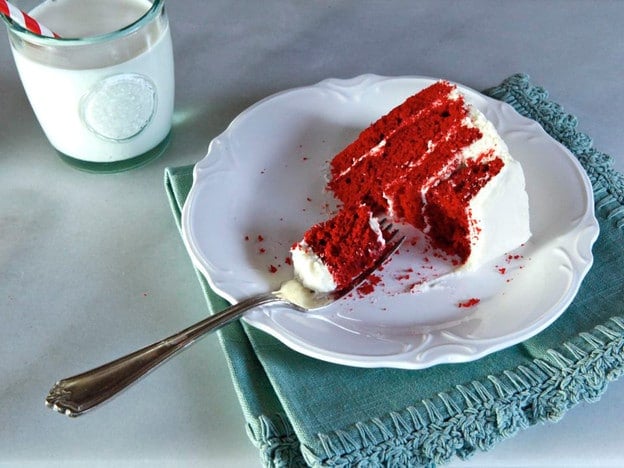
Food photography and styling by Tori Avey
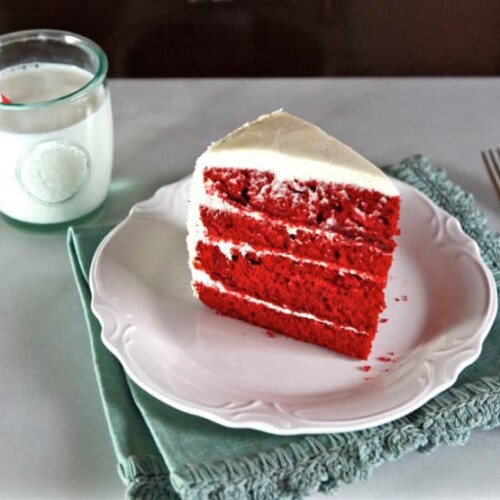
Red Velvet Cake
Ingredients
- 1/4 cup red food coloring (2 ounces/60 grams)
- 2 tablespoons unsweetened cocoa powder (10 grams)
- 1 1/2 teaspoons vanilla extract
- 1/2 cup vegetable shortening, or ¼ cup shortening and ¼ cup softened butter (65 to 67°F) (3.5 ounces/100 grams)
- 1 1/2 cups granulated sugar (10.5 ounces/300 grams)
- 2 large eggs (6 tablespoons plus 1 teaspoon/3.5 ounces/100 grams)
- 1 teaspoon salt
- 2 1/2 cups sifted cake flour or 2 cups plus 2 tablespoons all-purpose flour, sifted (8.75 ounces/250 grams)
- 1 cup buttermilk or sour milk (1 tablespoon white vinegar or lemon juice plus milk to equal 1 cup) (8.5 ounces/240 grams)
- 1 teaspoon distilled white vinegar
- 1 teaspoon baking soda
Cream Cheese Frosting Ingredients
- 1 cup cream cheese, softened (8 ounces/225 grams)
- 1/2 cup unsalted butter, softened, or Mascarpone cheese, at room temperature (65 to 67°F) (1 stick/4 ounces/115 grams)
- 1 pound confectioners' sugar, sifted (4 cups/455 grams)
- 1 teaspoon vanilla extract
Whipped Roux Frosting Ingredients (optional frosting choice)
- 5 tablespoons unbleached all-purpose flour (1.25 ounces/35 grams)
- 1 cup milk (8.5 ounces/230 grams)
- 1 cup unsalted butter, softened, or ½ cup butter and ½ cup vegetable shortening (8 ounces/225 grams)
- 1 cup granulated sugar (7 ounces/200 grams)
- 1 teaspoon vanilla extract
NOTES
Instructions
- Position a rack in the center of the oven. Preheat the oven to 350°F (325°F for a convection oven). Grease and flour two 9- by 2-inch round or three 8- by 1½-inch round baking pans.To make the batter: In a small bowl, gradually stir the food coloring into the cocoa until smooth. Add the vanilla.

- In a large bowl, beat the shortening and sugar until light and fluffy, about 5 minutes.

- Beat in the eggs, one at a time.

- Beat well after each addition.

- Blend in the cocoa mixture and salt.

- Add the flour alternately with the buttermilk (4 portions for the flour; 3 portions for the milk) beginning and ending with the flour. Overbeating produces a tough cake.

- Stir the vinegar into the baking soda. (It will foam.) Quickly fold it -— do not beat -— into the batter.

- Immediately divide the batter equally between the prepared pans and place in the oven.

- Bake until a wooden tester inserted in the center comes out clean and the cake springs back when lightly touched, about 30 minutes for the 9-inch pans or about 25 minutes for the 8-inch pans. Do not overbake or it will be dry.

- Let cool in the pans for 15 minutes, then remove the cakes to wire racks and let cool completely, at least 1½ hours.For thinner layers, the 9-inch rounds can be cut in half horizontally using a serrated knife. The cakes can be wrapped in plastic wrap and stored at room temperature for up to 2 days or the freezer for up to 2 months. Refrigerating or freezing the layers makes it easier to frost them without tearing or cracking.

- To make the cream cheese frosting: In a medium bowl, beat the cream cheese and butter until smooth, about 1 minute.

- Gradually add the sugar and beat until fluffy, about 4 minutes. Add the vanilla.

- To assemble: For 2 thick layers, leave the 9-inch rounds as is – for 4 thinner layers, cut them horizontally in half. Place a cake layer on a serving plate, spread with a layer of frosting. (Note - for 4 layer cake you will need more frosting, an extra half recipe should be enough).

- Frost, then arrange the next cake layer on top.

- Continue the layering, then spread the top and sides with the remaining frosting. Store in the refrigerator for up to 1 week.

Nutrition

tried this recipe?
Let us know in the comments!

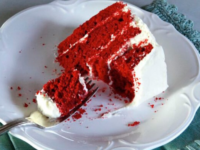
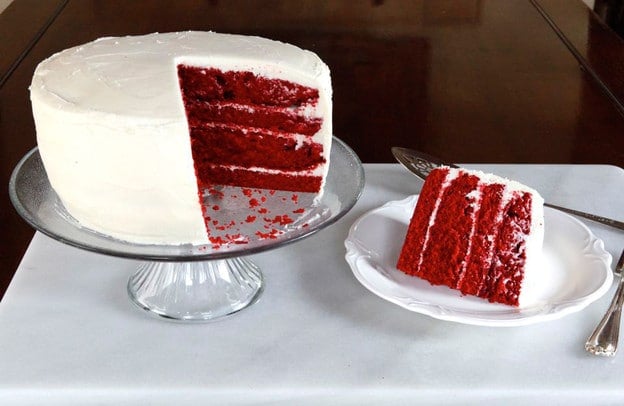
















I have been baking what I was told was Waldorf Astoria Red Cake since I was in high school in the 1960’s, getting my recipe from a friend of my mother’s who baked these cakes for us and others at Christmastime. She very willingly gave me her recipe and I have not veered from her recipe one whit because it was a delicious and unique cake with a special icing I’d never tasted before or since except on my own cakes ! That was what you call a roux icing. The icing really made the cake. I am now 69+ years old, still baking this cake for special occasions and always at Christmas as one of our traditions. The cake itself is nothing so special but is unique because of its denseness and very fine crumb. I did try several times to reduce the amount of red food coloring and had some ugly flops before settling on 1 oz. of color per 3-layer cake (yes, I bake this recipe in 3 – 9″ pans for a 3-layer beauty). I could see no difference in color after the 1 oz. amt. I am very disappointed that everyone today thinks the store-bought mix of ‘red velvet’ cake with cream cheese icing is the ‘original’ and I cannot eat it all. That’s just another mix with another icing. Your recipe is the closest thing to my original recipe I have ever read. Thank you for sharing the history and the recipe.
Right on Amy Johnson!
I totally agree! I have an old recipe with that “roux” Icing. It never disappoints! I just cringe when someone says “red Velvet Cake is just a chocolate cake with red food coloring”. They’ve obviously never had the original. I can not eat that delicate cake with that heavy, overly sweet cream cheese frosting.
I had an original recipe passed down that is very close to this recipe. However we used shortening in the frosting to make it whiter and used powdered sugar (you double it) so it is less grainy. I sift everything and use a double-boiler so nothing sticks. Time consuming yes. Well worth it. Most definitely. My family thinks its the greatest.
Can’t you freeze the layers and frost after thawing or can you freeze full cake
This is my favorite cake. I like the Roux frosting over the cream cheese. The cream cheese changes the taste of the cake
I bake and frost the cake and then divide it up and put in Tupperware. I freeze the cake so I can take out s smaller sections and enjoy them anytime! It still tastes the same after thawing.
I tried this cake for the first time and I love it… came out perfect.
I had a favorite red velvet cake recipe I lost in transitioning my recipes to a new cookbook. I’ve tried several new recipes, and this one is wonderful! The search is over! This recipe also makes 15-18 perfectly domed cupcakes, which is what my old recipe also did. Thank you!
Red velvet Is my favorite cake. I was disappointed. The cake wasn’t very rich or flavorful. I was hoping this was a real deal red velvet cake. It is not. Unfortunately I won’t be trying this recipe again.
I have been eating the original Red Velvet Cake with the original cooked icing and it is still my favorite cake. It took me forever to come across your recipe and all the history behind it, I thought this cake has to be the real deal. But I have to agree with Taylor I was disappointed. The cake was not as moist as I thought it should be, but I could probably fix that by not baking it as long. But I was really disappointed in the taste, it didn’t taste like all the red velvet I’ve been eating. Is there anything I can do differently to get that red velvet taste?
Tried the recipe and turn out good! Made it for my friend’s birthday and she loves it. Thank you so much for sharing the recipe.
Hi Tori! Can I use butter instead of shortening/oil? And how much? Really want to bake this for my husbands bday it’s his favorite cake. Thank you!
Hi Annwen, Tori’s assistant Ashley here. I’m sure there’s a way to use butter instead of shortening/oil for this recipe, however I do not know the exact conversion. Personally I find cakes baked with just butter to turn out dry in texture, but that’s just me!
I love the original frosting for red velvet cake. When I was a little girl, my Mom used to make it for my birthday because it was my favorite cake, hands down. What wonderful memories this brings back!
Thank you for a most interesting and informative post! In my humble (and, admittedly hyper-nostalgic) opinion, cream cheese icing should NEVER be used on a Red Velvet Cake – if one is inclined to strive for a cake that is fully authentic to The Original. That said, the “White Ermine” roux-based icing is a lot more work – with a couple of chances for failure – such as burning the milk mixture. Give me cream cheese icing on spice cake, carrot (and any number of other “cake vegetables), gingerbread, etc. Or just hand me a spoon.
I’m going to try this recipe this week! With the roux, is it firm and ice smooth like butter cream does? I need to know if it will withstand a 2 hour drive and an outside birthday at a park. Thanks in advance!
Hi Tori, I love so many of your recipes. I trust you over everyone else when I want authentic flavor. How can I avoid so many air bubbles in the cake? Tapping the pan on the counter?
Thank you,
Christie
Hi Christine, Tori’s assistant Ashley here. The best way to avoid air bubbles in cake mix is to be sure that you aren’t over mixing your batter. You can try to tap the pan on the counter to eliminate some of the bubbles, though it may not eliminate them entirely.
I followed the recipe carefully and it did not raise much and was quite dense. The flavor was excellent.
What could I do differently to improve the outcome next time?
Try to mix it for a shorter amount of time and check the use by date on your baking soda 🙂
You could sift the flour, baking powder, and salt. Then make sure it’s well combined. For a cake to rise the baking soda and salt play a big part.
BEST RED VELVET RECIPE EVER!! This is go-to when making a red velvet cake or cupcakes. I’ve made this at least 8 times and as long as you follow the recipe to a tee it will a home run cake every time! The amount of compliments I’ve gotten is overwhelming- this here is true authentic red velvet cake recipe that will always have people begging for more! I also must add that the shortening and buttermilk make it such a smooth and fluffy cake- MUCH better tasting than when made with oil. Thank you so much for posting this recipe! (And all the history behind it)
Can you use vegetable oil instead of the vegetable shortening for the cake mix?
I don’t recommend making this kind of substitution in any baked recipe.
Hello, Tori! What can I use instead of vegetable shortening to make this cake? It’s almost impossible to find in France. Thank you
Hi, Tori’s assistant Ashley here! I have heard of people having success with substituting butter or margarine in place of shortening, though I cannot guarantee the results will be successful since we haven’t tried it. If you do give this a try, please let us know how it turns out!
hi tori ! thanks for posting this recipe. I’m planning to make a cottage shaped cake with fondant covering. do you think this cake is firm enough to be carved ?
Hi, Tori’s assistant Ashley here! Unfortunately we don’t have any experience with carving cakes, but I’d imagine you need a dense cake to withstand the carving. I’m not sure this cake is best for that.
Many years ago, I made a green velvet cake for my college roommates. It tasted great, but we all p**ped green for a couple of days!
This recipe produces the real deal. No red velvet caked purchased in a bakery will even come close!
If you’ve never tried the cooked frosting, you really should. It is what makes this cake, it’s the part I crave and i don’t think it’s as rich and sweet as buttercream. Save the cream cheese for carrot cake. Follow instructions tho or it won’t turn out. I found out all butter doesn’t work, and you have to beat the butter and sugar well.
How long did you leave the baking soda and vinegar mixture before adding to the cake batter?
This is the identical recipe I have used since to
He late ’60s when I first had it while living in Charlotte NC. But it was not frosted with a Cream Cheese Frosting but one cooked on the stove which starts with a flour and butter rue. It is so much more complimentary of the cake and is in no way heavy and overpowering of the delicate cake flavor that is the true signature of this wonderful cake!!! At Christmas I make a green cake batter and a red cake batter. 3 layers of each color produces two cakes, one red, green, red and the second green, red, green. Frosted and sprinkled with silver candy pearl and dusted with c ales “snow” make a magical experience that when cut and served produce ohhhhhs and ahhhhhs and pure culinary joy by those your serve it to.